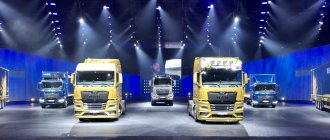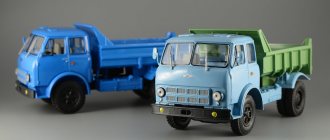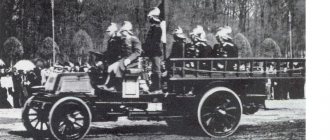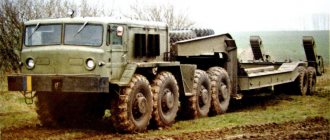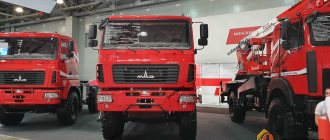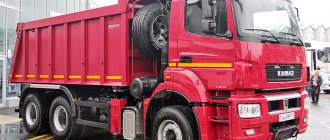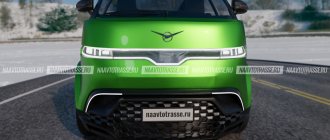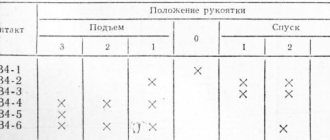VIS-2345 - first impressions
Among domestic products, IZH-2717 called “Oda-Version” is also present on the market, but the stars were so aligned that we ended up with a Togliatti product, although “Oda” is cheaper. Vans from various European manufacturers can be purchased from imported ones on the Russian market. These are mainly cars from French and German companies, the price is two to three times more expensive than the domestic product, but the quality and comfort are significantly better, and I took the car directly from the manufacturer, so before the new year 2005 I went to Tolyatti. In half a day we complete all the documents and insurance, and at night I set off in the direction of Moscow.
VIS-2345 has been produced for several years, the machine is familiar and popular to many. Briefly and primitively about the design: a frame was welded to the front half of the “five” and a body with a plastic superstructure was installed on it. This is how a delivery van with a carrying capacity of about 650 kg turned out. I drove more than one thousand kilometers in the “five”, so I didn’t find anything unusual or unfamiliar in the VIS cabin, except for the spare tire behind the passenger seat. And so, all the same uncomfortable seats, after which a sore back cannot recover for a long time, paddle shifters that were convenient for their time, a noisy but effective stove fan and the famous VAZ switch keys, from which the entire Union was dragged 20 years ago.
The tires on the new car are summer, and I was immediately warned that the rear axle on a slippery road breaks off instantly when I press the gas pedal. I nod my head - we’ll check now. I leave the parking lot and accelerate. After fourth gear I try to switch to fifth, but I am surprised to find that there is no gear. I thought that 4-speed “boxes” are no longer installed on new cars, but here it’s such a disappointment.
The federal highway is all covered with ice, so cars drive slowly. At the first opportunity I start overtaking. I switch to downshift, move to the left and put the gas to the floor. Instead of accelerating, the car begins to wag its back no worse than a woman with good shape. The unloaded rear axle of an empty car on longitudinal semi-elliptical springs loses traction with the road earlier than you expect, so on the VIS you need to carefully use the gas on a slippery road, even if there are studded tires, which we later became convinced of during operation. In addition, excessive skidding of the rear axle also occurs on dry asphalt in turns, in which the usual “five” passes, as they say, without “fools”. Nowadays I sometimes use this, tearing off the rear axle with a squeal and skidding with the gas in sharp turns in front of the amazed owners of foreign cars.
But at night, without oncoming traffic, I allowed myself to break away, sometimes “swagging my tail” on the ice at speeds of up to 120 km/h. By the way, a good remedy for sleep, adding adrenaline to the blood, unless, of course, you end up in a ditch first. By morning, periodically arguing with traffic cops, I reached Moscow.
A few days later I’m going to my “native” traffic police department to register the car. The inspector refused to give it a technical inspection, citing a large play somewhere in the steering, which was determined, moreover, by eye. This is on a new car. A “cop” is like a red rag to a bull for me, so after raising a scandal and reaching the boss, I get a technical inspection.
At the moment, the car has driven about 20 thousand km and there have been practically no problems with it. It should be noted that we immediately replaced the engine oil with imported oil with a viscosity of 10-40, and installed two fuel filters into the fuel line at once, since the engines come from the factory without them. VIS, as a rule, is operated half empty. Sometimes, when picking up magazines from a printing house, several trips have to be made with a maximum load of 650 kg. Then you realize that the engine power is 70 hp. not enough for a confident ride, and carburetor injection has long been outdated. Fuel consumption was an unpleasant surprise: on the highway it was almost 12 liters per 100 km, but at a speed of 100-120 km/h, and in the city it was only 14 liters. We did not adjust the carburetor and ignition of the new car.
The car is noisy - you don’t want to drive more than 100 km/h, since the roar of the engine and transmission puts pressure on your ears and blocks the radio. And the fifth gear is oh so missing. The steering is annoying. Firstly, due to the long wheelbase, the turning radius has become like that of a truck, and secondly, it is clearly designed for strong people - charging is provided in the morning and throughout the day. And since a lady often rides on our VIS, sometimes I feel sorry for her, but this is the only moment when I feel sorry for women.
The body of our “donkey” is comfortable. The absence of wheel arches and a folding tailgate allow the Euro pallet to be placed transversely. The loading height is almost 800 mm, but this is the price for a flat floor. Personally, I prefer the latter over wheel arches. The problem with our van is that the rear door seal is not tight. At speed in wet weather, rain dust is pulled inside through bad seals like a vacuum cleaner. We've already ruined a hundred magazines this way, so we carry boxes in the van, where we put the load.
Summing up the first acquaintance, I would like to note: the car’s layout is successful, but the 25-year-old “five” base is so outdated that you don’t want to drive it for a long time. And if you do go, it won’t be for that kind of money – almost $6,500. Without fail, on VIS I would install power steering and a 5-speed gearbox, preferably different seats and engine injection. We’ll tell you about the quality and reliability of the car in the following stories.
Trucks from Tolyatti
photo by Vladimir Korbut
About ten years ago, even under a planned economy, each of the domestic factories produced a certain range of cars, prescribed by the State Planning Committee and strictly observed. Thus, light vans with a carrying capacity of up to 500 kg were created only on the basis of Moskvich and were produced first by the Moscow Small Car Plant, and since 1975 only by the Izhmash association. And God forbid that, without the approval of the party and government, some plant - for example, VAZ - would undertake the production of similar cars created on the basis of its own models. But perestroika began, the first cooperatives appeared, immediately feeling the urgent need for microtrucks. Izhevsk “hairpieces” were going great at that time. The rest of the car factories also responded to the request of the emerging market; they then received, albeit not yet complete, independence. And the first here was the Volzhsky Automobile Plant, which created a two-seater “Bison” with an on-board platform from VAZ-2121 Niva components. And although the car turned out to be quite nice, it was received ambiguously, primarily due to the desire of many drivers to have a more passenger-carrying car. Nevertheless, the Bizon was produced, but not at VAZ, but at its subsidiary VAZinterServis, formed in 1991, under the VIS-2346 brand. The Nivov variants were followed by mini-trucks based on the VAZ Five and Eight.
VAZ minitrucks
Unlike well-known domestic pickups that have a monocoque body, these VISs have a semi-frame frame structure. This allows, on the one hand, to mount various bodies on the same chassis - from a flatbed platform to an insulated van, and on the other hand, to make all three sides of the platform folding, which greatly facilitates the use of the body. I have long dreamed of driving these cute pickups and vans based on VAZ cars, but in our capital city I could not find sellers of the products of VAZinterService CJSC. And finally, my dream came true, and we got three different versions of these vehicles for testing: a five-seater pickup truck based on the Niva with a VIS-23461 flatbed platform and two microtrucks based on the VAZ-2105 - VIS-2345 with a closed plastic top, flatbed platform and VIS-23452 with a van-type body. So, let's begin our acquaintance with these machines.
The rear suspension of all three cars under consideration is not the traditional “Zhiguli” on springs with transverse thrust, but leaf spring, which is quite justified from a design point of view. Also, all three have an increased wheelbase: for VIS 2345 and -23452 - by 340 mm compared to passenger models of the classic Zhiguli, and for VIS-23461 - by 150 mm, when compared with the VAZ-2131, and by 650 mm, when compared with the regular Niva.
The rear suspension of all VISs is leaf spring, but the VIS-23461 is more solid and has additional leaves
All this makes these vehicles very similar in appearance to our usual trucks - ZiLs and GAZikis. And one more thing: VIS cars based on the “five” have more powerful VAZ-2103 engines under their hoods.
This is general. Now let's look at the features of each model.
VIS-2345
The most remarkable thing about this small, neat truck, created on the basis of the components and assemblies of the classic VAZ-2105, is its body. It is a platform with folding sides made of duralumin (all three can be folded), closed on top with a removable cap made of white plastic. The latter has a smoothly rounded shape. As soon as you turn the rear wall lock, it easily rises up, where it is held by two shock absorbers similar to the shock absorbers of the rear door of the VAZ-2108 - 09. Now you can fold back the rear door locks and lower it. You will see a spacious compartment with a length of 1900 mm, a width of 1660 mm and a height of 1150 mm (platform area 3.15 square meters).
VIS-2345
The small loading height (600 mm) makes loading and unloading convenient, but the low ceiling of the cargo compartment forces you to either push the goods being transported along the floor all the way to the cabin, or crawl inside, bent over. The rear wheel arches that protrude into the body also interfere, albeit slightly. True, if you remove the plastic cap, turning the car into an ordinary truck, then you can fold down the side, which greatly simplifies loading and unloading operations. The car quite quickly transports up to 650 kg of luggage.
Other design features include the location of the gas tank filler neck on the rack next to the right door, from which a wide rubber gas pipe goes to the fuel tank, and from the tank there is a bright blue plastic tube for air exhaust. And all this is in plain sight, open. This decision, in my opinion, is far from indisputable: I, for example, would try, out of harm’s way, to cover these hoses with some kind of light casing. The low position of the muffler also causes criticism.
Inside the two-seater cabin is the familiar interior of the Zhiguli “five”. The cabin is long enough to provide the driver's seat with the necessary fore-and-aft movement. The spare wheel is located like on the IZH-2715 - behind the back of the passenger seat. What deserves special attention is the overview of the rear hemisphere. We already noted in No. 8 for 2000 that the old “hairpieces” were dark and blind cars, with almost nothing visible in the right mirror. The VIS-2345's mirrors are simply wonderful! I don’t know of any domestic passenger car that would have such large side rear-view mirrors! Unless only on UAZs.
VIS-23452
It differs from the previous truck only in its van-type body. The booth, made of aluminum, has a volume of 4 cubic meters. m and is also designed to carry 650 kg of cargo. The joints of the body panels are carefully sealed and sealed with plastic seals. The van is installed slightly higher, 200 millimeters, than the VIS-2345 onboard platform, due to which it has a completely smooth floor inside. The roof of the cargo compartment is also slightly higher, which makes loading and unloading easier.
VAZ-23452
Another nice feature is that the van doors can be opened 270 degrees by placing them along the sides and locking them in this position, for which there are corresponding loops and hooks on the doors. This allows you to open the cargo compartment doors in advance and drive the vehicle to the loading ramp located in a narrow space.
I can make perhaps the only comment regarding this body concerning the locks of the left door leaf. If the right door opens and closes easily, with one turn of the lock, like the trunk lock of a Volga, then the locks on the left look very much like the secret bolts of ancient school hall doors - they open with difficulty and close with even greater difficulty. An insulated van is much more convenient from this point of view.
VIS-23461
This option differs from the VIS-2346 “Bison” in having a five-seat cabin and a shortened side platform with a plastic cap. This truck caused the greatest controversy among members of the test group precisely because of the size of the cargo compartment - some thought it was too small. However, when I compared it with the IZH-27151 body, it turned out that the area of the VIS-23461 platform was only 30 sq. m. cm less than that of the “chignon”. Really, this is not such a big difference, it’s just that the VIS body has a more square shape (which is sometimes even more convenient). Moreover, a car with a short body has the same carrying capacity as a car with a long platform - 640 kg.
Compared to the “five-speed” versions of mini-trucks, the “Nivovsky” pickup truck has a more powerful rear axle suspension, which is generally understandable - it is an SUV after all.
Unlike the VAZ-2121, the rear seat of the car in question is not clamped by wheel covers, and three people can easily fit on it. One thing is not entirely good - with the front seats pushed back as far as possible, the knees of the passengers sitting behind them rest against their backs (well, exactly like on the VAZ-2120 Nadezhda). The rest is the same as the original Niva.
We got acquainted with minitrucks, so to speak, statically. Now it's time to test them in dynamics.
VIS minitruck test
The first van that came into my hands was VIS-23452 . Despite the fact that the grip of the wheels shod in summer tires on the road covered with packed snow was clearly insufficient, I managed to move the car slowly and without slipping. At the same time, I did not feel any differences in the dynamics of acceleration and braking compared to the regular “five”. When we threw a dozen bags of sugar into the back, starting off on a slippery road ceased to cause difficulties at all, although the weight of the load still made its own adjustments to the control.
The extended wheelbase, on the one hand, contributes to a smooth ride, but, on the other hand, in combination with the “five-wheel” steering, it requires the driver to be more careful when maneuvering, especially in narrow passages. First of all, this applies to drivers who have extensive experience driving Zhiguli “classics”. Habit is an insidious thing!
When reversing, you have to navigate like in a real truck - using the mirrors. But thanks to their size, this operation did not cause me any stress.
The second was VIS-2345 with an airborne platform. Depending on who you choose, I immediately got the impression that this car was lighter and faster than a van. However, the powerful “three” engine in combination with the empty aluminum body immediately caused the summer tires to slip on the packed snow of the road. He also had to throw the same ten bags of sugar into the truck, after which the problem disappeared (studded tires also have the same effect).
VIS-2345
A more streamlined flatbed body with a plastic top makes this car more economical than a van, but this advantage is revealed mainly when traveling long distances on intercity highways.
Otherwise, there are no big differences between options 2345 and 23452 .
I experienced the greatest pleasure from controlling the VIS-23461. Powerful, playful car, no problems with starting or braking! Thanks to the long wheelbase, the car has good directional stability and a smooth ride. But this same long wheelbase, as in the case of VIS 2345 family, requires a lot of attention when maneuvering. And how great it is to overcome snow on VIS-23461! The only negative is higher fuel consumption compared to models based on conventional passenger cars, which is quite natural for a jeep.
Let's summarize some results. All three vehicles are quite suitable for transporting small quantities of cargo. They are comfortable, easy to drive, familiar to drivers, beautiful and surprisingly neatly made. In my opinion, options with long bodies and based on the “five” are still more preferable for use as a workhorse. But in general, each technique will find its buyer.
The editors thank you for the cars provided.
Technical characteristics of VIS-23461 and VIS-2345
| VIS-23461 | VIS-2345 | |
| Capacity | 5 people | 2 people |
| payload | 640 kg | 640 kg |
| permissible maximum weight | 1970 kg | 1790 kg |
| maximum speed | 100 km/h | 100 km/h |
| engine | VAZ-21213 | VAZ-2103 |
| engine's type | 4-stroke, carburetor | 4-stroke, carburetor |
| working volume | 1.7 l | 1.5 l |
| power | 58 kW, (78.9 hp) | 52.5 kW, (71.4 hp) |
| drive unit | 4x4 | 4x2 rear |
| size: base / length / width | 2850 mm / 4460 mm / 1660 mm | 2800 mm / 4380 mm / 1660 mm |
| cargo platform dimensions (external) | 1275x1660 mm | 1900x1660 mm |
| Vladimir Novitsky | |
| VAZ accepted the challenge... Finally, VAZ has launched a series of pickup trucks that are so necessary for private entrepreneurs, small businesses, and BUSINESS in general. Consignments of such machines have already begun to arrive in Novosibirsk. When I saw them, honestly, my heart rejoiced! First. The appearance is pleasing to the eye. Second. A “troika” engine was installed on the basis of the “five”. Forced cooling or an electric fan drive is available as an option. Third. For the convenience of the driver and passenger, seats from “06” are used in the cabin. Fourth. Finally they made viewing mirrors normal. Fifth. I like that the cargo compartments are located on longitudinal frames so that the body itself is already considered semi-framed. Due to the frame and rear leaf springs, the load capacity has increased. By the way, the body is offered in three versions: just a booth, isothermal and transforming. I liked the “transformer” body better. You can remove the cap, unfold the sides and, using a trailer that has been familiar to us for a long time, transport, in my opinion, even oversized cargo. What I would advise the developers of these models to think about is the lighting in the booths (there is none) and the location of the spare tire. The latter is located behind the passenger seat. Although, it seems to me that for a savvy Russian driver such shortcomings are not a problem. He is not an advanced Japanese who, without a computer, will not be able to determine how and where to fit the spare tire and install the lighting. This applies to rear-wheel drive models. But the “transformer” body based on the Niva (VAZ-21213) is already something! This pickup truck was generally born for our conditions. I would say this is a multifunctional Russian SUV, only more powerful and more capable than pickup trucks. The same half frame, the same full mirrors. I was pleased that by lengthening the half-frame, the rear wheel arches, which take up a lot of space in the cabin of the base Niva and cause inconvenience for passengers, went into the cargo compartment. Therefore, the cabin can accommodate three people in the rear seats. I believe that such cars will be in demand, they have a future. | |
| Evgeniy Maslin | |
| The production of cars of this kind is very beneficial from the point of view of the coherence of the production process. Making a new model is extremely labor-intensive and expensive, so minitrucks are built on the basis of proven models. This creates a number of advantages: identical spare parts, proven maintenance and repair technologies (and this is a very big plus). The production of this kind of machines is designed to meet the needs of small and medium-sized businesses - for urban and suburban cargo transportation. This need is apparently caused by the insufficient availability, from the point of view of the auto giants of the domestic auto industry, of inexpensive and convenient minitrucks on the market. Many years ago, the plant in Izhevsk mastered the production of the famous “hairpieces” (IZH-2715), but as you know, “Muscovites” could not always boast of their reliability... When you sit in the VIS model, you feel at home - this is an ordinary domestic “classic”, everything is familiar and familiar. Still, no matter how hard our designers try, no matter how scientific and technological progress moves both here and over the hill, we are accustomed to working the old fashioned way always and in everything. So in our case, these cars are not free from shortcomings, even the most visible ones. An example is the location of the exhaust pipe: the outlet is located on the side, approximately in the middle of the car, and as soon as you open the door, all the smoke is in your cabin. What if there is still wind from behind? With all this, it doesn’t cost anything to take all this farming back. The location of the filler neck suggests that you should be careful at the gas station: it is not recommended to spill gasoline past, it can stink through you with a not-so-fragrant smell! The rear marker headlights are located quite low (15 centimeters lower than those of the base models). They are not large in size, which is not at all safe. The VIS-2345 model is made with an aerodynamic curve of the cargo compartment to reduce wind resistance, and this will pay off on a long journey. The cargo compartment exceeded all expectations! Models VIS-2345 and -23452 are very spacious. It won’t be a problem to transport even very large cargo (on the 2345 you can lower the sides down). But the 2345 model has wheel arches inserted into the cargo compartment (this is a big minus and may not always be convenient). When driving, the light body (much lighter than the engine) of the VIS-2345 model does not add to the dynamic properties to any extent, especially during acceleration. Even with studded tires, you can skid anywhere, and if the roads are unclean, then it’s really bad. The thought immediately comes to front-wheel drive (either pulling a heavy front, or pushing it). The long wheelbase of the VIS-23461 and the not very high ground clearance are unlikely to allow driving in large mud areas in the village. As soon as you “sit on your belly,” the car will be sucked in and it will be difficult to push out. Still, the wheels are a bit small; wider tires could be used for the 4x4 variants. And you won’t be able to ride over the bumps too much: you can get caught on the bottom. The cargo compartment of 23461 causes some complaints - if the car is supposed to work in rural areas, then the cargo compartment should not be reduced at the expense of the rear passenger seats (which I can hardly fit in alone!). For firewood, humus, etc., such a handsome man is simply irreplaceable, but you have to agree, if you’re bringing it, it’s all at once. Comfortable! | |
Truck tractor VIS-23454
This pickup truck, with a fifth wheel mounted instead of a platform or body, immediately became in demand.
The original design VIS-9474, developed by TPF Pchelnikov and Sons LLC, is used as a PP.
VIS 23454 with a semi-trailer model 910500 can transport up to 1.2 tons.
VIS-23454 with semi-trailer
Purpose
This category of road trains is used for transporting agricultural products, fertilizers, soils, long cargo - pipes, lumber, etc.
Dimensions and design features
The dimensions of the semi-trailer in the flatbed version are 3.85 × 1.61 meters (length Lxwidth H), in the frame version - 5.66 × 0.99 m (LxH). Accordingly, the length of the road train is 6.9 or 8.1 m.
Cabin 34454 can be installed from “seven” or “five”.
The SSU provides the ability to rotate in the horizontal plane by 18 degrees, and in the vertical plane by 13.
The brake system is connected using hydraulic cylinders, which ensure quick coupling of the PP with the tractor and the absence of air in the system when the devices are disconnected.
In 1997, the semi-frame VIS-2345 was born, taking the place of the VAZ-21043-33. This time it was VAZinterservice’s own development, which was reflected in the model index. The fundamental difference from the previous pickup model is the presence of a unified half-frame (tested by this time on the VIS-2346 model), which is welded to the cabin side members. The car's cabin is a standard VAZ-2105 or VAZ-2107 front, cut off behind the middle pillar, to which the rear wall is welded, which can be either solid or have glazing in the upper part. Cars of the first years of production were equipped with standard “five-point” rear-view mirrors, but later, taking into account the significantly protruding dimensions of the body, the car received enlarged rear-view mirrors. Unlike the standard VAZ-2104, the VIS-2345 received a fundamentally different rear suspension on longitudinal springs, which made it possible to increase the load capacity of the pickup truck (it is noteworthy that the VIS-2345 of the first years of production had springs running under the drive axle. Subsequently, the fastening of the springs became more common - over the bridge). The car, like the VAZ-2104, had a classic rear-wheel drive layout. The gearbox on the pickup truck uses a standard VAZ one, so the gear ratios in it have not changed. Likewise, the main gear of the drive axle with a gear ratio of i=3.9 has not changed. To increase the useful volume of the body, the vehicle's base was increased by 375 mm compared to its passenger car predecessor, but at the same time the turning radius became 6.9 meters. Given the lack of a trunk as such, the spare tire was moved into the cabin behind the back of the passenger seat. The fuel tank is located immediately behind the cabin in the frame, while the fuel line leading to the filler neck is led out on the starboard side. The VIS engine initially used a standard 1.5-liter engine, but since 2006, cars have been equipped with 1.6-liter engines. Cars are painted under an agreement with AvtoVAZ in its painting booths in the same colors that VAZ cars are painted in. Initially, pickup trucks (cabin and frame) were painted only with conventional auto enamels, but since 2010, VIS pickup trucks, along with “classic” ones, can also be painted metallic. The carrying capacity of the basic flatbed version is 350 kg (490 kg including the weight of the driver and passenger). Depending on the version, three configurations of VIS-2345 pickups are distinguished: VIS-2345-0000001 - a semi-frame chassis designed for installation of bodies by the consumer VIS-2345-0000010 - a flatbed pickup with an aluminum profile body and three folding sides - the basic version of the VIS-2345 -0000012 – flatbed pickup truck with a plastic superstructure over an aluminum body. The assembly of these vehicles (along with VIS-2346) in August 2000 was also established at the Kiev Automobile Repair Plant No. 5. Currently, pickup trucks of the VIS-2345 family occupy two-thirds of the enterprise's output. The ten thousandth VIS-2345 pickup truck was produced on January 23, 2004 - it was the VIS-2345 with a plastic superstructure over the body.Semi-trailer for VIS-23454
The non-self-propelled vehicle for the VIS 23454 truck tractor is available in both single-axle and two-axle versions. Naturally, in the second case, as a result of load distribution, the mass of transported goods increases from one ton to 1.2 tons.
PP are manufactured on a welded frame. Two modifications are available - onboard and platform, which is equipped with bunks if necessary.
Semi-trailer for VIS-23454
